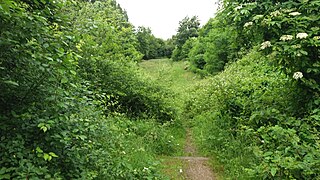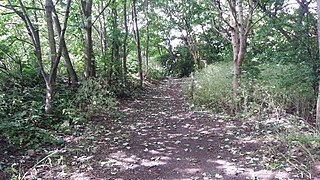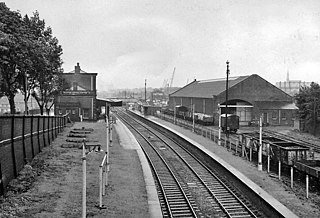
The West Midlands Metro is a light-rail/tram system in the county of West Midlands, England. The network has 33 stops with a total of 14 miles (23 km) of track; it currently consists of a single route, Line 1, which operates between the cities of Birmingham and Wolverhampton via the towns of Bilston, West Bromwich and Wednesbury, on a mixture of former railway lines and urban on-street running. The system is owned by the public body Transport for West Midlands, and operated by Midland Metro Limited, a company wholly owned by the West Midlands Combined Authority.

Bilston is a town in Wolverhampton, in the West Midlands, England. It is close to the borders of Sandwell and Walsall. The nearest towns are Darlaston, Wednesbury, and Willenhall. Historically in Staffordshire, three wards of Wolverhampton City Council now cover the town: Bilston East and Bilston North, which almost entirely comprise parts of the historic Borough of Bilston, and Ettingshall, which comprises a part of Bilston and parts of Wolverhampton.

Coseley is a village in the Dudley Metropolitan Borough, in the West Midlands County, England. It is situated three miles north of Dudley itself, on the border with Wolverhampton. Though it is a part of the Dudley North constituency. It also falls within the Wolverhampton South-East parliamentary constituency.
The South Staffordshire line is a partially mothballed and active former mainline that connects Burton-upon-Trent to Lichfield in Staffordshire and formerly then to the West Midlands towns of Walsall, Wednesbury, Dudley and Stourbridge. However, Dudley and Stourbridge were already joined to the Oxford, Worcester and Wolverhampton Railway's (OW&WR) line just north of Dudley Station. It in essence, continued to Stourbridge along with Wednesbury and Walsall.

Dudley railway station was a railway station in Dudley, Worcestershire, England, built where the Oxford-Worcester-Wolverhampton Line and the South Staffordshire Line diverged to Wolverhampton and Walsall and Lichfield respectively.

Harts Hill railway station was a station on the Oxford-Worcester-Wolverhampton Line. It was opened in 1895 by a GWR keen to invest in what was perceived to be the lucrative passenger area of the Black Country, and it was intended to serve the communities between Brierley Hill and Dudley. It closed, like many passenger stations, in 1917 due to the First World War, but was consequently never reopened when the passengers failed to materialise. Two railways/routes served the station - originally the Oxford, Worcester and Wolverhampton Railway and the South Staffordshire Railway, which later became the Great Western Railway and London, Midland and Scottish Railway respectively.

Wolverhampton Low Level was a railway station on Sun Street, in Springfield, Wolverhampton, England.

Tipton Five Ways railway station was a station built by the Oxford, Worcester and Wolverhampton Railway, serving the town of Tipton in the western section near the border with Coseley for 88 years from 1853.

Princes End and Coseley railway station was a station built by the Oxford, Worcester and Wolverhampton Railway in 1853. It was one of two stations in Princes End, but was situated closer to Coseley, which influenced the decision in 1936 to add the 'and Coseley' tag on the end of the station name. It was situated on the Oxford-Worcester-Wolverhampton Line. The station eventually closed in 1962, along with the passenger services along the line, although the line remained open to goods trains until 22 September 1968.

Daisy Bank railway station was a station built by the Oxford, Worcester and Wolverhampton Railway in 1854 as Daisy Bank & Bradley station. It was situated on the Oxford-Worcester-Wolverhampton Line. The station closed in 1917 as a wartime economy measure before reopening in 1919, and closed permanently in 1962, though goods trains continued to pass through the site until the line closed completely on 22 September 1968.

Priestfield railway station was a junction station built by the Oxford, Worcester and Wolverhampton Railway in 1854. It was situated on the junction of the Oxford-Worcester-Wolverhampton Line and the London Paddington to Birkenhead via Birmingham Snow Hill. The station closed in 1972, although mainline services were withdrawn by 1967, and only single railcars operated to Snow Hill, the OWW Line closing in 1962. It was the first station south of Wolverhampton Low Level. After the withdrawal of passenger services, the line remained open to goods trains until December 1982.

The Birmingham Snow Hill to Wolverhampton Low Level Line was part of the Great Western Railway's London Paddington to Birkenhead Woodside route. As the name suggests, it ran between Birmingham Snow Hill and Wolverhampton Low Level in England. The line was dual-gauged, both 7 ft 1⁄4 in and 4 ft 8+1⁄2 instandard gauge.

Bilston Central railway station was a station on the London Paddington to Birkenhead via Birmingham Snow Hill line. It was built in 1854 and served the town of Bilston in the West Midlands. It closed in 1972, with the end of passenger services on the Snow Hill and the line to Wolverhampton, although goods trains continued to pass through the site of the station until this section of the line was closed in January 1983. It saw a second incarnation when a Midland Metro stop of the same name was opened a few hundred yards away in May 1999.

Wednesfield railway station was a station built by the Wolverhampton and Walsall Railway in 1872, and was operated by the Midland Railway from 1876 onwards. It served the Wednesfield area of Wolverhampton, and was located near to Neachells Lane.

Willenhall Stafford Street railway station was a station built by the Wolverhampton and Walsall Railway in 1872, and was operated by the Midland Railway from 1876 onwards. It served the town of Willenhall, and was located to the north of the town centre. It was originally named Willenhall Market Place.

Darlaston James Bridge railway station was a station built on the Grand Junction Railway in 1837, serving the James Bridge area east of the town centre of Darlaston, near the junction of Walsall Road and Bentley Mill Way.

Willenhall Bilston Street railway station was a station built on the Grand Junction Railway in 1837. It served the town of Willenhall, and was located just to the south of the town centre. It was one of two railway stations in the town - the other being Willenhall Stafford Street.

Wolverhampton is a city and metropolitan borough in the West Midlands, England. The population was 263,700 in 2021. People from the city are called "Wulfrunians". The city is located 12 miles (19 km) north-west of Birmingham.
Ettingshall Road railway station was a railway station built by the London and North Western Railway on their Stour Valley Line in 1852. It served the Ettingshall area of Wolverhampton, and was located near to the junction of Ettingshall Road and Parkfield Road.
The Buckinghamshire Junction Railway, often known as the Yarnton Loop, was a standard gauge railway between Buckingham Junction on the Oxford, Worcester and Wolverhampton Railway (OW&WR) and Oxford Road Junction on the Buckinghamshire Railway. It was opened on 1 April 1854 to enable OW&W trains to and from Wolverhampton to connect with London and North Western Railway trains to and from London Euston.

















